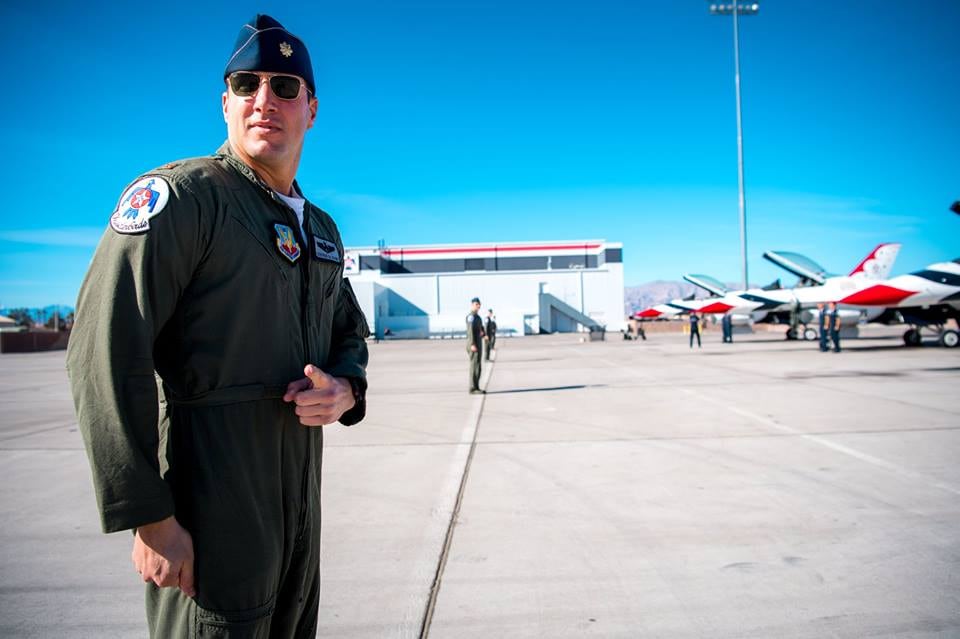Thunderbirds pilot Maj. Stephen Del Bagno temporarily lost consciousness during a high G-force maneuver and was incapacitated right before a fatal crash in April.
The Air Force on Tuesday released the report on the investigation into the April 4 crash at the Nevada Test and Training Range near Nellis Air Force Base.
Del Bagno, along with five other elite Thunderbird pilots, was practicing an aerial maneuver called the High Bomb Burst Rejoin, and flew inverted for about 22 seconds at about 5,500 to 5,700 feet above ground level, where he experienced up to negative two G-forces, the report said.
Del Bagno then started a descending half-loop maneuver called the Split-S, reaching a maximum of 8.56 Gs after five seconds, the report said. The extreme G-forces caused him to lose consciousness and be absolutely incapacitated for the next five seconds.
About a second before hitting the ground, the report said he recovered somewhat and started trying to recover his F-16CM, but it was too late. He did not attempt to eject.
RELATED

The accident investigation board found that the “push-pull effect” of quickly going from -2.06 Gs — or twice the equivalent of standing on one’s head — to 8.56 Gs dramatically lessened his tolerance to G-forces, and substantially contributed to the crash. Those conditions also lessened the effectiveness of his anti-G force straining maneuver.
Del Bagno, whose call sign was “Cajun,” was an experienced F-35 pilot, whose love of flying, enthusiasm and excitement for his first season with the Thunderbirds was apparent to all. In a January video documenting the moment he and other newly minted Thunderbirds received their iconic red flight helmets, Del Bagno called it “a fantastic day.”
His death rocked the Air Force, and especially the Thunderbird community, which grieved his loss. Air Force Secretary Heather Wilson and Chief of Staff Gen. Dave Goldfein were among those who expressed their grief. Fighter jets flew a missing man formation during a memorial service for Del Bagno at his high school in Santa Clarita, California, in April.
The Thunderbirds, known formally as the U.S. Air Force Air Demonstration Squadron, suspended public performances for six weeks after Del Bagno’s loss.
The report said Del Bagno was known as “an ‘inspirational’ leader who was always positive and put others before himself.”
“The merger between his positive personality and pilot skills made him a ‘perfect fit for the Thunderbirds' mission to recruit, retain and inspire,” the report said. “A member of his squadron summed up [Del Bagno] as ‘just a beautiful human being.’”
Del Bagno appeared in good spirits before the flight, the report said, and was current and qualified to fly. He had a reputation for exceptional physical fitness and had carried out many high-G maneuvers successfully in the weeks prior to the mishap.
But the report said that physical fitness does not protect against the physiological effects of negative-Gs, which can widen blood vessels and result in a loss of blood pressure and lowered heart rate. This can increase the danger when a pilot quickly shifts to high G-forces, which tends to pull the blood to the abdomen and lower extremities and away from the brain.
The F-16 was not overdue for any inspections, and there was no indication of any recurring maintenance problems or any mechanical, structural or electrical failure that would have contributed to the crash.
Stephen Losey is the air warfare reporter for Defense News. He previously covered leadership and personnel issues at Air Force Times, and the Pentagon, special operations and air warfare at Military.com. He has traveled to the Middle East to cover U.S. Air Force operations.





